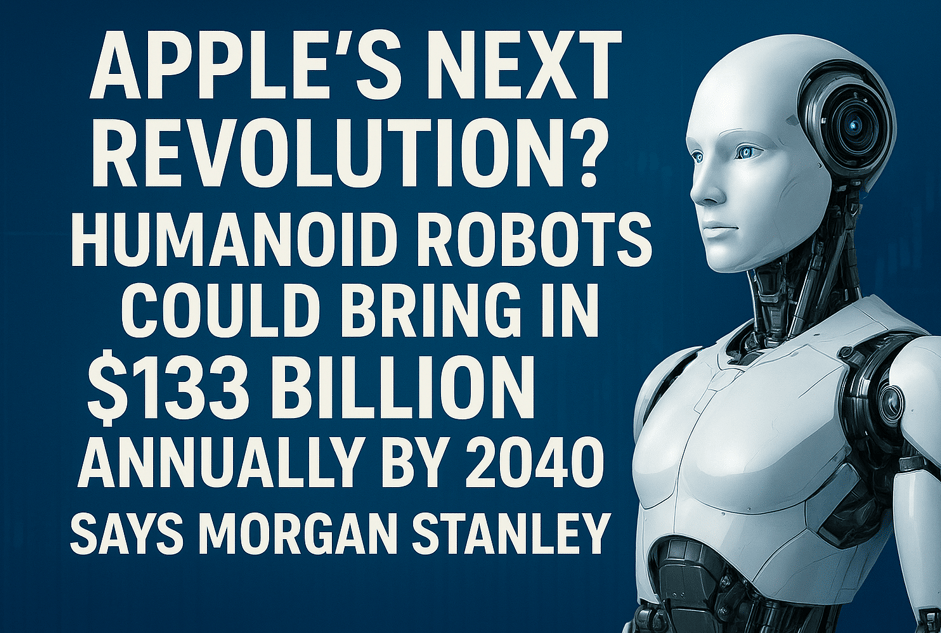- Live Life Grow Wealth
- Posts
- Apple’s Next Revolution? Humanoid Robots Could Bring In $133 Billion Annually by 2040, Says Morgan Stanley
Apple’s Next Revolution? Humanoid Robots Could Bring In $133 Billion Annually by 2040, Says Morgan Stanley

Today’s Headline
Apple could make $133 billion a year on humanoid robots by 2040: Morgan Stanley
If there’s one thing Apple has proven over the decades, it’s that it doesn’t just enter industries — it reshapes them. From the iPhone redefining communication to the Apple Watch revolutionizing wearables, every new product from the Cupertino giant has rewritten market rules. And now, according to Morgan Stanley, Apple could make an astonishing $133 billion a year by 2040 from humanoid robots.
Let’s pause for a second — $133 billion isn’t a small number. That’s roughly the size of some countries’ entire GDP. So, the question is: how realistic is this forecast, and what could it mean for the future of technology, investments, and even the global job market?
🚀 “Discover the ad-platform driving growth while investors sleep—click here and find out how AudienceMaker gives you the edge your portfolio needs!”
Build better audiences in minutes, not weeks.
Speedeon's AudienceMaker gives you instant access to 1000+ data points to build and deploy audiences across 190+ platforms like Meta, Google, TikTok, and Amazon.
No data team required. Pay as you go. Request a demo and get a free customer analysis, so you can find more just like them!
The Humanoid Robot Race Is Heating Up
When most people hear “robots,” they still imagine machines in factories welding car parts or robotic vacuum cleaners gliding across the floor. But the next generation of robots — the humanoid kind — is something else entirely. These are robots designed to walk, talk, see, and respond almost like humans.
Tesla’s Optimus, Figure AI’s Figure 02, and Boston Dynamics’ Atlas are among the frontrunners today. However, Apple joining the race changes everything. Apple has the advantage of ecosystem integration, brand trust, and software excellence. Imagine a humanoid robot that connects seamlessly with your iPhone, manages your schedule, recognizes your voice through Siri, and helps around the house — all powered by Apple’s AI and chip technology.
If Apple truly steps into this market, it won’t be a simple robotics play — it’ll be the next revolution in personal computing.
Why Morgan Stanley’s Prediction Matters
Morgan Stanley isn’t known for making wild guesses. When the investment bank predicts that Apple could earn $133 billion annually by 2040 from humanoid robots, it’s grounded in long-term trends:
Massive Demand for AI Integration:
As AI becomes more advanced, the demand for intelligent machines that can think and act autonomously will explode.Aging Global Population:
In many developed countries, populations are aging rapidly. Humanoid robots could fill gaps in caregiving, home maintenance, and companionship.Apple’s Cash Power and Ecosystem:
Apple can pour billions into R&D without hurting profitability. It already has the hardware (chips), software (AI systems), and user base to create a seamless transition into robotics.
So, Morgan Stanley’s projection isn’t far-fetched — it’s a calculated look at where technology and human behavior are heading.
The Vision: Apple’s “iBot”?
If Apple does launch a humanoid robot, we can almost predict how it might look and function. Apple doesn’t sell features — it sells experiences.
Picture this: a sleek, minimalist robot with a smooth aluminum finish, built-in LIDAR sensors, and a “face” display that changes expression. It could respond to your voice, follow you around, help with groceries, or even act as a digital assistant that goes beyond screens.
The robot would likely run on Apple Silicon, use Apple Intelligence for contextual understanding, and sync effortlessly with HomeKit devices. You could tell it, “Hey Siri, clean up the living room,” and it would get to work, learning your preferences over time.
That’s the Apple way — merging technology with lifestyle.
The Economics Behind the Prediction
Let’s break down how $133 billion in annual revenue could make sense.
Suppose Apple sells humanoid robots at an average price of $25,000 — which is not unreasonable for a high-end, AI-powered device by 2040 standards. For Apple to reach $133 billion in revenue, it would need to sell roughly 5.3 million units per year.
Sounds big? Not really. Apple sells around 200 million iPhones annually today. So selling 5 million robots globally — especially two decades from now — is entirely possible.
Additionally, Apple doesn’t rely solely on hardware sales. Its strength lies in services. Imagine recurring revenue from robot software updates, maintenance, AI upgrades, and subscription plans. The robots could have app ecosystems like iPhones — maybe even an “App Store for Robotics.”
That’s how Apple turns a one-time sale into a lifetime relationship.
Why Apple’s Entry Could Change Everything
Every time Apple enters a market, competitors feel the heat. When it launched the Apple Watch, Fitbit’s market share plummeted. When the iPhone arrived, Nokia disappeared from the map.
Here’s why Apple’s entry into humanoid robotics could be a game changer:
Consumer Trust:
People already trust Apple with their personal data. That’s crucial when you’re talking about a robot living in your home, hearing your conversations, and learning your routines.Seamless Integration:
Apple products work together effortlessly. This integration could make owning an Apple robot feel as natural as owning an iPhone or Mac.Premium Market Power:
Apple can charge premium prices and still create demand. While competitors might struggle with affordability, Apple users have proven they’re willing to pay more for reliability and brand prestige.AI Ecosystem Leverage:
Apple’s focus on “Apple Intelligence” — its own take on generative AI — means the robot could become smarter over time. It could integrate real-world AI with emotional awareness and privacy-focused intelligence.
The Humanoid Economy: Jobs, AI, and Automation
There’s another side to this story — one that affects all of us.
If humanoid robots become mainstream, what happens to millions of jobs that involve manual or repetitive labor? From household help to factory workers, the landscape of employment could shift dramatically.
But here’s where it gets interesting — history shows that every major technological revolution creates more opportunities than it destroys. When ATMs arrived, people feared the end of bank tellers. Yet, banks expanded, and tellers evolved into financial service providers.
Similarly, humanoid robots could open doors for:
AI maintenance and training jobs
Robot design and customization industries
Personal AI coaching and integration services
The human workforce won’t disappear — it will evolve. Those who learn how to work with robots instead of competing against them will thrive.
"Boost your investment strategy by unlocking the power of CTV advertising with Roku Ads Manager—learn how to maximize returns this holiday season. Click here to explore!"
Find your customers on Roku this Black Friday
As with any digital ad campaign, the important thing is to reach streaming audiences who will convert. To that end, Roku’s self-service Ads Manager stands ready with powerful segmentation and targeting options. After all, you know your customers, and we know our streaming audience.
Worried it’s too late to spin up new Black Friday creative? With Roku Ads Manager, you can easily import and augment existing creative assets from your social channels. We also have AI-assisted upscaling, so every ad is primed for CTV.
Once you’ve done this, then you can easily set up A/B tests to flight different creative variants and Black Friday offers. If you’re a Shopify brand, you can even run shoppable ads directly on-screen so viewers can purchase with just a click of their Roku remote.
Bonus: we’re gifting you $5K in ad credits when you spend your first $5K on Roku Ads Manager. Just sign up and use code GET5K. Terms apply.
The Investment Perspective
Now, from an investor’s point of view, this story is fascinating.
If Apple truly pivots into humanoid robotics, this could unlock one of the largest growth opportunities in decades. Just as the smartphone era minted new billionaires and industries, the humanoid robot era could do the same.
Here’s how investors might think about it:
Apple as the Core Play:
Apple remains the most obvious beneficiary. If its robot plans materialize, it could significantly boost revenue, diversify product lines, and expand margins through software subscriptions.Suppliers and Partners:
Companies supplying chips, sensors, and materials to Apple could also see huge gains. Think of TSMC, Broadcom, or robotics component makers.AI and Cloud Companies:
The robots would need immense computing power. That means cloud and AI infrastructure providers could see soaring demand.
Investors should also remember — Apple plays the long game. It doesn’t rush to be first; it waits to be the best. So while competitors are showing off prototypes, Apple might be quietly perfecting something far superior.
Potential Challenges
Of course, the road to humanoid dominance won’t be smooth.
Ethical Concerns:
People will question the privacy implications of having a robot that listens and observes daily life.Regulatory Hurdles:
Governments might introduce strict rules on AI-driven robots, especially in sensitive areas like caregiving or child interaction.Cost and Accessibility:
Early models could be too expensive for most households. Apple would need time to scale production and make it affordable.Technical Limitations:
True humanoid behavior — walking naturally, understanding emotions, adapting to unpredictable human behavior — remains an incredibly complex challenge. Even the best robots today look robotic.
Yet, these hurdles never stopped Apple before. The company thrives on turning impossible problems into everyday conveniences.
My Personal Take
If you ask me, this prediction from Morgan Stanley feels bold but believable. Apple is one of the few companies with the patience, capital, and vision to redefine what “personal technology” means.
The humanoid robot could become the next iPhone moment — not because it’s cool or futuristic, but because it becomes useful. When technology becomes practical, it spreads like wildfire.
The key, however, will be execution. Apple will need to balance innovation with privacy, affordability with luxury, and automation with human connection.
Final Takeaways
Here’s my takeaway for you as a reader and investor:
Stay ahead of trends. The robotics and AI revolution is already here — and Apple’s entry could be the spark that lights the next wave.
Think long-term. We’re not talking about short-term stock moves; this is about the technology that could shape the next 15 years.
Diversify smartly. Don’t chase hype. Instead, look at companies that power this transformation — chipmakers, AI developers, and sensor manufacturers.
Learn and adapt. As automation evolves, our best investment is still in ourselves — learning new skills to thrive alongside AI.
If Apple truly earns $133 billion annually from humanoid robots by 2040, it won’t just be another product launch. It’ll mark a new era — where robots don’t just serve industries but live with us, assist us, and maybe, in some way, become part of our families.
And if history has taught us anything about Apple, it’s this: when they dream, they don’t dream small. They build the future.
[Live Life Grow Wealth]
🎓 Free Masterclasses to Unlock Your Investment Potential
Take your money skills to the next level with expert-led workshops designed to help you grow smarter and faster.
Recommendations Section
“Peek into smart money moves — when big players act, you’re in the loop.”
|
Learn simple, proven ways to grow your money — straight from real investors who walk the talk.
|
“Hone your investing edge in just 5 minutes — smart, snappy insights to power your portfolio growth.”
|
“Stay ahead with one expert-picked stock monthly — clear, no jargon, built for growth.”
DISCLAIMER
I make no representations, warranties, or guarantees, whether expressed or implied, that the content provided is accurate, complete, or up-to-date. Past performance is not indicative nor a guarantee of future returns.
I am an individual content creator and not regulated or licensed by the Monetary Authority of Singapore (MAS) as I do not provide investment services.
All forms of investments carry risks, including the risk of losing your entire invested amount. Such activities may not be suitable for everyone. You are strongly encouraged to seek advice from a professional financial advisor if you have any doubts or concerns.








